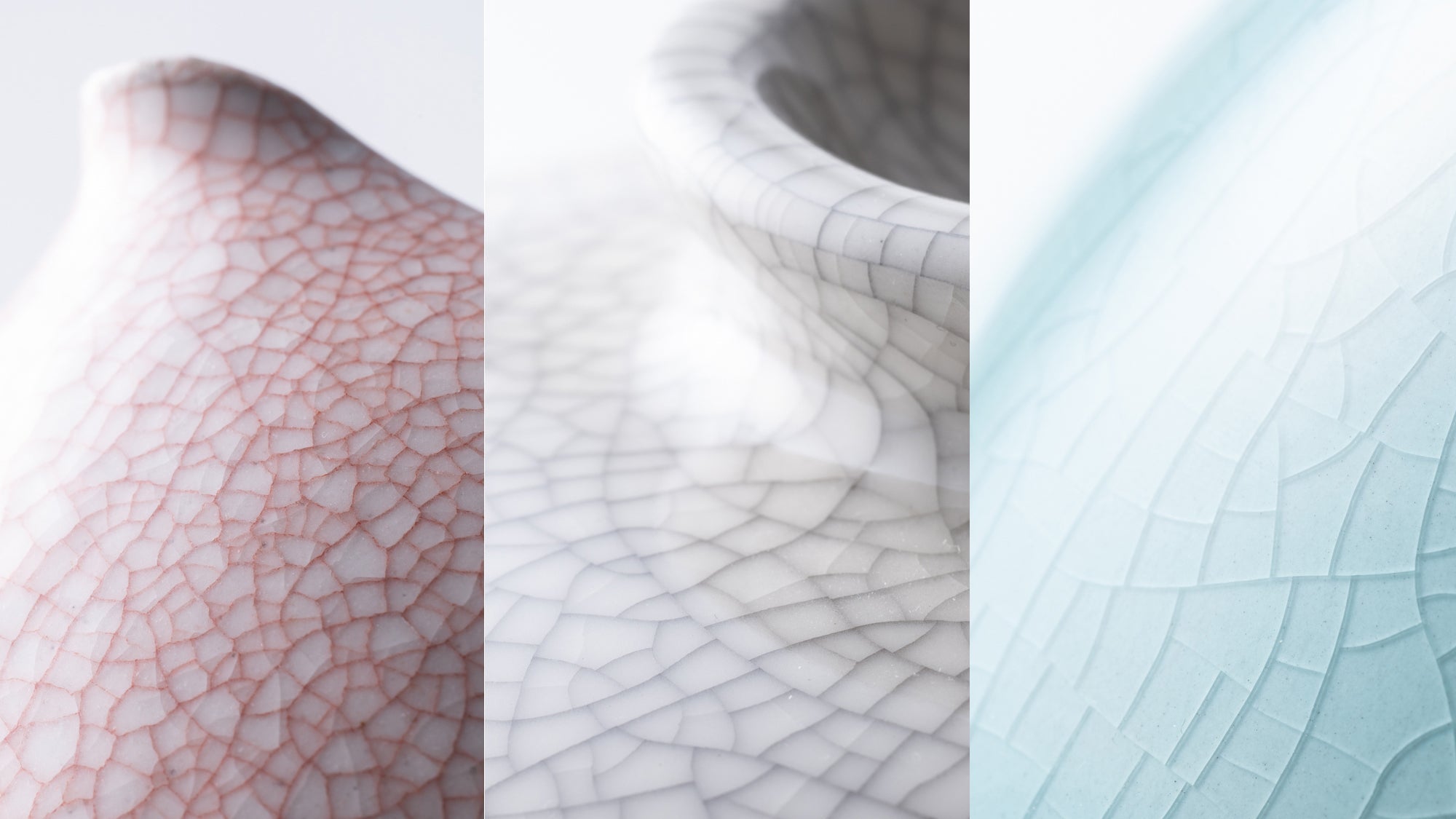
Imperfect Beauty: Cracking the Code of Kannyu
Written by Team MUSUBI
The porcelain's surface, smooth and lustrous as jade, is evenly covered with delicate, fine cracks, reminiscent of the cracking ice on a warm spring day, seemingly emitting a crisp yet faint sound of cracking. It also resembles the traces of willow branches left in the snow during a pristine winter, spreading across the entire surface of the porcelain.
The presence of this pattern neither detracts from the beauty nor the functionality of the porcelain; instead, it infuses the piece with a lively vitality and a fragile beauty. This special pattern is known as kannyu. As a decoration on celadon ware, kannyu represents a natural cracking texture on the glaze of the porcelain. Depending on its shape, it has been given many names, such as "ice crackle pattern," "willow leaf pattern," and "ox hair pattern."
Moreover, to accentuate the effect of the cracks, some works are deliberately coated with iron oxide or ink after being removed from the kiln. Let us delve deeper into the intricate world of kannyu, a pattern challenging to create yet incredibly beautiful.
tables of contents
Tracing Kannyu's Origins through the Long River of History

As the carrier of kannyu, celadon porcelain, with its origins in China, made its way to Japan by the 10th century. During that era, the aristocracy held Chinese celadon wares in high esteem as the most exquisite imported items. They were captivated by its enigmatic blue hue, referring to it as the "secret-color." The crafting of celadon ware commenced in the Hizen area, located in what is now the northwestern part of Kyushu, during the early Edo period (1603 CE -1868 CE). This art form subsequently spread to Kyoto and surrounding regions. In 1957, the techniques involved in making celadon porcelain were honored as a national intangible cultural asset. Even today, celadon porcelain continues to be cherished and is actively produced by numerous potters and artists.

Originally perceived as a flaw in porcelain making, kannyu was seen by the ancient Chinese of the Song Dynasty (960 CE -1279 CE) as a rare form of imperfect beauty, thus assigning it an aesthetic value. This appreciation was further amplified by Emperor Huizong of Song, known for his artistic refinement, who had a particular fondness for kannyu. Consequently, porcelain craftsmen began to intentionally utilize the natural cracking patterns in their creations, leading to the deliberate production of "ice crackle" patterns. As the methods and skills of porcelain making spread to Japan, Japanese artisans adapted and evolved these techniques, giving rise to a localized approach to porcelain design and production.
Features of Kannyu: Fragile Beauty

The elegant celadon porcelain with kannyu not only serves its function as a utensil but also gains favor with creators and users who appreciate beauty due to its artistic nature as a traditional craft. As a result, it has been continuously evolving and developing. Compared to ceramics worldwide that pursue a sense of beauty that admires perfection, the beauty of Japanese ceramics is believed to lie in their uneven, nature-close forms. The style of the crackle pattern exudes a sense of infinite extension, resembling a calm lake surface covered with cracked ice, adding a fragile beauty to the already delicate and breakable porcelain. It also reflects the Japanese spirit of mono no aware, expressing a profound, lasting, and gentle sadness for the transient and impermanent aspects of life.
Kokuzo Kiln Camellia Kutani Yunomi Japanese Teacup

The green, blue, and yellow teacups employ kannyu. During the cooling process after the ceramics are removed from the kiln, variations in the contraction rates of the surface glaze and the ceramic body in the air result in intricate patterns resembling ice cracks on the surface of the ceramics.
Each cup features the motif of camellia flowers, which in Japanese haiku poetry symbolize the arrival of spring. Just as spring arrives, warming the weather and causing winter's ice to slowly melt and crack, the camellia flowers also begin to bloom. This creates a dynamic imagery on the otherwise static cup walls, allowing us to glimpse the arrival of spring.
The artist has skillfully rendered the camellia's form with graceful strokes, complemented by various base colors. When we use these differently colored tea cups on our dining table, it feels as if we've brought the colorful essence of spring into our homes.
Hibino Blue Gradation Modern Mino Ware Bowl

This bowl also uses kannyu technique, which intentionally creates a crack-like pattern that can be seen under the glaze.
Featuring a simple and modern design, this Japanese bowl displays a beautiful gradient of blue. It is handcrafted by Hibino Ceramic, a studio specializing in creating tableware that not only enhances the appeal of a dish but also makes it visually stunning.
In addition to its excellent design, the bowl is durable and user-friendly, attributes that have made it popular in restaurants both in Japan and internationally. Mino ware, a traditional type of Japanese tableware, is widely known for its abundant production and use of high-quality clay.
The kannyu adds more aesthetic appeal to the celadon porcelain, and the beautiful yet practical tableware brings a sense of seasonality and fun to our dining tables. It allows us to appreciate the beauty of the ice crack pattern right at our home tables, enhancing the texture and richness of our daily life.







Leave a comment
This site is protected by hCaptcha and the hCaptcha Privacy Policy and Terms of Service apply.